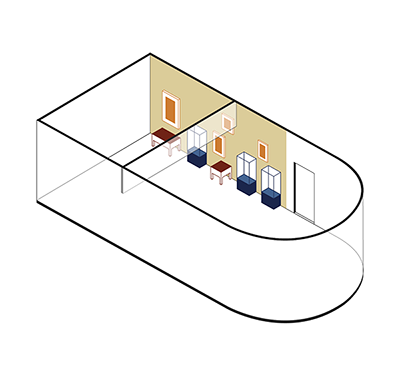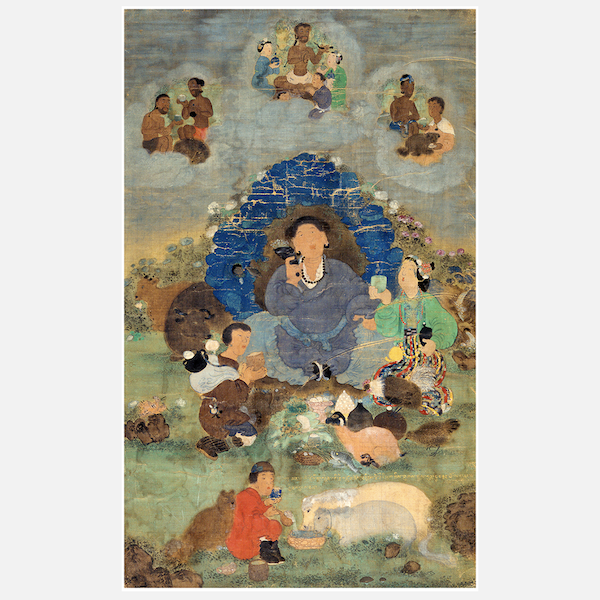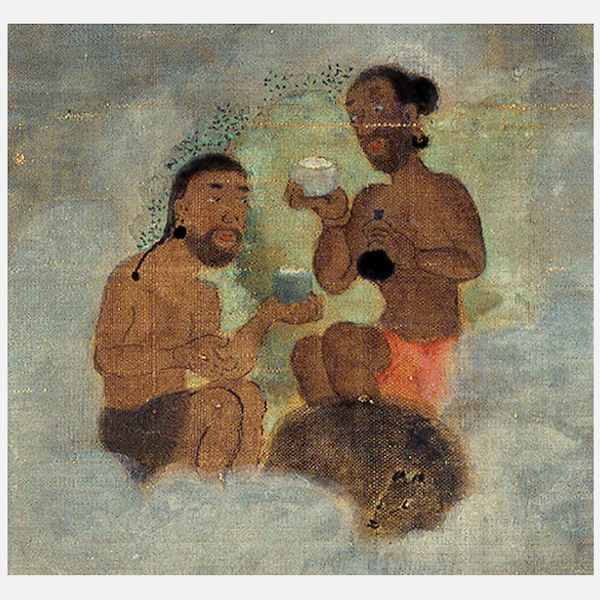Marpa the Translator receiving Milarepa by Karmapa 10 Chöying Dorje (1604-1674)
See it in the Museum

Chapel
Orientation 4
Wall object 17

ABP 058
Code: ABP 058
Country: Tibet (east)
Style:
Date: 1600 - 1700
Dimensions in cm WxHxD: 31.4 x 50.5
Materials: Distemper on silk
Marpa Lotsaba Receives Milarepa Painted by the Tenth Karmapa Chöying Dorje
In the center sits Marpa Lotsaba (1012–1097), the founder of the Kagyü tradition, and principal teacher of Milarepa (1040–1123). Marpa is clad in the voluminous garments of a lay tantric master. His wife Dakmema, wearing a green dress, is seated to his left. In the foreground a young men dressed in a red robe is feeding a cow and a horse, possibly it is their son Darma Dode. On the proper right side of Marpa kneels the young Milarepa, carrying the shoulder bag of a traveller. Marpa and his entourage are surrounded by numerous animals, among them mountain sheep, cows, a cock with colourful feathers, a hen, and even a fish. The upper part shows representations of Mahasiddhas: On the left side the lineage holder Tilopa (988–1069) teaching his successor Naropa (956–1040). Depicted in the centre in turn is Naropa teaching Marpa Lotsaba, accompanied by his wife Dakmema. On the right an unidentified master is teaching Milarepa. He wears a white shawl over his shoulders and holds a dog in his lap. An inscription attributes this painting on silk to Chöying Dorje, the Tenth Karmapa (1604–1674): “This image of Marpa the translator is a spiritually charged painting [by] the venerable Chöying Dorje. He gave to his intimate disciple Kuntu Zangpo”. The painting could date from 1641, when the Karmapa first met Kuntu Zangpo, unless the inscription was added to a painting done earlier. Only very few of the paintings attributed to Chöying Dorje bear a dedicatory inscription. The Karmapa’s approach to painting and sculpture is characterised by his compassionate and realistic rendering of wildlife. This much published painting on silk by Chöying Dorje is not only an outstanding work of art, but also very significant due to the profound spiritual and historical connection with the Kagyü tradition.
In the center sits Marpa Lotsaba (1012–1097), the founder of the Kagyü tradition, and principal teacher of Milarepa (1040–1123). Marpa is clad in the voluminous garments of a lay tantric master. His wife Dakmema, wearing a green dress, is seated to his left. In the foreground a young men dressed in a red robe is feeding a cow and a horse, possibly it is their son Darma Dode. On the proper right side of Marpa kneels the young Milarepa, carrying the shoulder bag of a traveller. Marpa and his entourage are surrounded by numerous animals, among them mountain sheep, cows, a cock with colourful feathers, a hen, and even a fish. The upper part shows representations of Mahasiddhas: On the left side the lineage holder Tilopa (988–1069) teaching his successor Naropa (956–1040). Depicted in the centre in turn is Naropa teaching Marpa Lotsaba, accompanied by his wife Dakmema. On the right an unidentified master is teaching Milarepa. He wears a white shawl over his shoulders and holds a dog in his lap. An inscription attributes this painting on silk to Chöying Dorje, the Tenth Karmapa (1604–1674): “This image of Marpa the translator is a spiritually charged painting [by] the venerable Chöying Dorje. He gave to his intimate disciple Kuntu Zangpo”. The painting could date from 1641, when the Karmapa first met Kuntu Zangpo, unless the inscription was added to a painting done earlier. Only very few of the paintings attributed to Chöying Dorje bear a dedicatory inscription. The Karmapa’s approach to painting and sculpture is characterised by his compassionate and realistic rendering of wildlife. This much published painting on silk by Chöying Dorje is not only an outstanding work of art, but also very significant due to the profound spiritual and historical connection with the Kagyü tradition.





